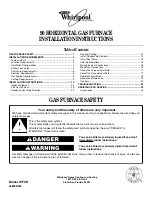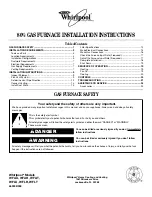
21
• Be aware that the hotter the fire, the less creosote is deposited, and that weekly cleaning can be necessary
in mild weather, even though monthly cleaning can be enough in the coldest months.
• Have a clearly understood plan to handle a chimney fire.
TAMPER WARNING
This wood heater has a manufacturer-set minimum low burn rate that must not be altered. It is against federal
regulations to alter this setting or otherwise operate this wood heater in a manner inconsistent with operating
instructions in this manual.
VISIBLE SMOKE
The amount of visible smoke being produced can be an effective method of determining how efficiently the
combustion process is taking place at the given settings. Visible smoke consist of unburned fuel and moisture
leaving your stove. Learn to adjust the air settings of your specific unit to produce the smallest amount of visible
smoke. Wood that has not been seasoned properly and has a high wood moisture content will produce excess
visible smoke and burn poorly. Use the included moisture meter to insure your wood has a 20% or less moisture
content.
EFFICIENCY
Efficiencies can be based on either the lower heating value (LHV) or the higher heating value (HHV) of the fuel.
The lower heating value is when water leaves the combustion process as a vapor, in the case of wood stoves the
moisture in the wood being burned leaves the stove as a vapor. The higher heating value is when water leaves
the combustion process completely condensed. In the case of wood stoves this would assume the exhaust gases
are room temperature when leaving the system, and therefore calculations using this heating value consider
the heat going up the chimney as lost energy. Therefore, efficiency calculated using the lower heating value of
wood will be higher than efficiency calculated using the higher heating value. In the United States all wood stove
efficiencies should be calculated using the higher heating value. The best way to achieve optimum efficiencies
is to learn the burn characteristic of you appliance and burn well-seasoned wood. Higher burn rates are not
always the best heating burn rates; after a good fire is established a lower burn rate may be a better option for
efficient heating. A lower burn rate slows the flow of usable heat out of the home through the chimney, and it
also consumes less wood.
SMOKE AND CO MONITORS
Burning wood naturally produces smoke and carbon monoxide(CO) emissions. CO is a poisonous gas when
exposed to elevated concentrations for extended periods of time. While the modern combustion systems in
heaters drastically reduce the amount of CO emitted out the chimney, exposure to the gases in closed or confined
areas can be dangerous. Make sure you stove gaskets and chimney joints are in good working order and sealing
properly to ensure unintended exposure. It is recommended that you use both smoke and CO monitors in areas
having the potential to generate CO.
OVER FIRING
Attempts to achieve heat output rates that exceed heater design specifications can result in permanent
damage to the heater
OPERATIONAL TIPS
• Get the appliance hot and establish a good coal bed before adjusting to a low burn rate (this may take 30
minutes or more depending on your wood), for an optimal low burn rate, once there is a well established
fire in the furnace, close the damper on the door, and the rear pilot air damper completely, and open the
secondary air damper to its maximum setting
• Use smaller pieces of wood during start-up and a high burn rate to increase the stove temperature
• Be considerate of the environment and only burn dry wood
• Burn small, intense fires instead of large, slow burning fires when possible
• Learn your appliance’s operating characteristics to obtain optimum performance
• Burning unseasoned wet wood only hurts your stoves efficiency and leads to accelerated creosote buildup
in your chimney.
CAUTIONS:
• Ashes could contain hot embers even after two days without operating the furnace.
• The ash pan can become very hot. Wear gloves to prevent injury.
• Never burn the furnace with the ash trap open. This would result in over firing the furnace. Damage to the
furnace and even house fire may result.
Summary of Contents for Clayton CL1660E
Page 9: ...9 INSTALLATION ADD ON INSTALLATION...
Page 27: ...27...








































